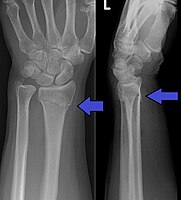
Photo from wikipedia
BACKGROUND Ulnar metacarpal base fractures can destabilize the carpometacarpal (CMC) joint, prompting surgical stabilization. Studies investigating this injury are limited by small case volumes. Our purpose is to review the… Click to show full abstract
BACKGROUND Ulnar metacarpal base fractures can destabilize the carpometacarpal (CMC) joint, prompting surgical stabilization. Studies investigating this injury are limited by small case volumes. Our purpose is to review the surgical techniques, outcomes, and complications of ulnar CMC joint stabilization. METHODS A literature search was performed of all articles published on the surgical treatment and outcomes of ulnar CMC fracture dislocations using PubMed and Google Scholar databases between the years 2014 and 2019. Data were pooled and analyzed, assessing surgical techniques and hand outcome measures: union, recurrent dislocations, range of motion, grip strength, and complications. RESULTS Six studies met inclusion criteria. All surgical patients, regardless of technique, went on to union with no incidents of recurrent instability. Grip strength was significantly decreased postoperatively (82.7% of uninjured side). Patients with CMC dislocations of both the fourth and fifth ray had similar postoperative outcomes to those with CMC dislocations of the fifth ray alone. One third of plate and screw constructs required plate removal, due to breakage (2) or implant-related pain (4). Plate-related symptoms resolved after removal in all cases. Delayed treatment decreased the effectiveness of nonoperative treatment, and increased the likelihood of postoperative pain, chronic deformity, malunion, and CMC osteoarthritis. CONCLUSIONS Closed reduction percutaneous pinning, open reduction percutaneous pinning, and open reduction internal fixation with CMC joint bridging or dorsal buttress plating are all well described, safe techniques with low complication rates. Early, accurate diagnosis of fourth and fifth CMC joint fracture-dislocations is crucial for optimizing hand function and postoperative outcomes.
Journal Title: Hand
Year Published: 2020
Link to full text (if available)
Share on Social Media: Sign Up to like & get
recommendations!